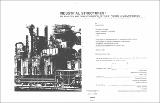Industrial structures : an analysis and transformation of their formal characteristics
Author(s)
Strub, Damon
DownloadFull printable version (31.61Mb)
Alternative title
Analysis and transformation of their formal characteristics
Other Contributors
Massachusetts Institute of Technology. Department of Architecture.
Advisor
Fernando Domeyko.
Terms of use
Metadata
Show full item recordAbstract
Industrial structures such as blast furnaces, oil refineries, gravel crushers etc. are often beautiful and fascinating. Furthermore, they exemplify certain formal and organizational characteristics which could be incorporated into architectural design. In the 1920's Le Corbusier and his contemporaries refereed to industrial structures, American grain silos in particular as a symbol of their Positivist faith in rationalism and anticipation of a Techno - Utopia. However, the world has changed in the last 60 years. Contemporary architecture is struggling to move beyond this Positivistic utopian vision and create a built environment which is more humane, user friendly and accommodating of idiosyncrasy and diversity. This thesis will examine four characteristics exemplified by industrial structures which could inform such an architecture. Industrial structures are heterotopically ordered complex assemblages of autonomous components. Discrete, clearly defined spaces within them are displaced so as to allow residual or slack space in between. The exposed steel frame work creates a sense of transparency and blurs the edge between inside and out. The purely utilitarian lack of artifice creates an honest and legible tectonic expression. These four characteristics cannot be applied superficially as an end in themselves. They should evolve out of the design process. Industrial structures are organized according to strict functional, utilitarian and economic criteria. It might be possible to archive these characteristics in architecture by following the same functional methodology. However, this is difficult in architecture because not only are the functional requirements obscure and complex but there is often little correlation between form and function. In architecture, the experiential as well as the technical qualities of a building must be considered. Helmut Schulitz's three C's context, construction method and content, defines a broad categorization of functional criteria which can influence the form of a building. However, no matter how broadly defined, a purely rational, functional design approach is insufficient to create architecture. Some degree of formal compositional order is unavoidable. To illustrate the incorporation of these characteristics into architecture, I have designed a community center to be located on the Boston State Hospital site at Franklin park. This design attempts to follow a heterotopic functional methodology based on Helmut Schulitz's Three C's categorization. The various activities of the center are organized around a plaza. The plaza is open to the southwest and commands a view of the field below and the blue hills in the distance. In summation, this thesis proposes four characteristics discernible in industrial structures which could inform a more diverse and humane architecture. It then proposes how these characteristics can be achieved by following a functional design methodology. This approach is illustrated with the design of a community center located on the Boston State Hospital Site.
Description
Thesis (M. Arch)--Massachusetts Institute of Technology, Dept. of Architecture, 1988. Includes bibliographical references (leaf 60).
Date issued
1988Department
Massachusetts Institute of Technology. Department of ArchitecturePublisher
Massachusetts Institute of Technology
Keywords
Architecture.